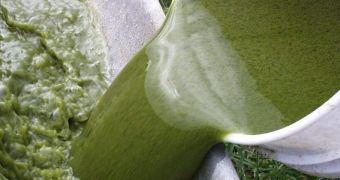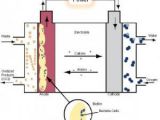I would really like to live and say this line, the guy at the pump would probably laugh himself to death before filling the tank of the car. Imagine going home to your wife saying: 'Honey can you give me some money? I've just spent 20 bucks on pig manure... I was out', and her being like: 'You did what?'. Traditional fuel cells usually work on hydrogen gas; however, while waiting for the improvement of the fuel cell design, some scientists decided to study alternative means of producing electric energy.
Such a team from the Biodesign Institute is using bacteria to breakdown organic residue like waste water, sewage and manure to generate electricity. Mankind produces a lot of biomass containing large amounts of energy, that is just dumped throughout the environment. Bruce Rittmann from the Center for Environmental Biotechnology, argues that, instead of just storing this waste, we could take it, keep it or convert it into a liquid form in order for the bacteria to digest it, process that takes place with release of electric energy. It would be like a symbiotic relationship between us and the bacteria, they get food while we get power.
The possibility of using microorganisms for such processes is further backed up by the fact that bacterial life forms can digest mostly any type of waste provided to them. However, this is not as simple as it may seem, as the metabolism of the microorganisms must be precisely synchronized with the electricity production stage and could potentially eliminate some crucial components used in the hydrogen fuel cells to produce electric power at relatively low costs.
As any type of fuel cells, the basic concept of the newly proposed design involves a similar principle as that of the hydrogen fuel cell. The so-called MFC reactors would consist of two terminals, that represent the anode and the cathode electrodes, submerged into a conductive electrolyte solution which create a flow of electrical current between the two electrodes in order to generate electric power.
The anode of the reactor consists of bacteria breathing in and out during the process of decaying the organic waste into carbon dioxide gas, which releases electrons that travel to the cathode through an external circuit, where a second stage takes place as the electrons released by the cathode are picked by oxygen and hydrogen gas to form water.
If you are wondering how you determine a bacteria to provide the anode with electrons, the fact is that you don't have to. Bacteria depend on the anode presence to live, thus they form a biofilm around it.
Andrew Kato Marcus, one of the leading authors of the study, explains that, in macroscopic conditions, most of the electric conductors are represented by metals which have a relatively high electron mobility. However, in the case of biofilms, the electrical current is determined by changes in the electrical potentials in the bacterial self-generated matrix, that is practically a living anode.
Studies have shown that, as long as a bacterial community has food, it will grow; furthermore, the presence of an electric potential at the anode increases the growth rate, as the potential rises. This process is described by the team with a new model developed by them, called the Nernst-Monod equation, that accurately predicts the rate of bacterial growth in relation with the electrical potential applied.
It seems that the only waste material resulted from this process is the biofilm of bacteria deposited on the anode. The team also discovered that the optimal output of power is being provided by the fuel cell when the bacterial biofilm presents a particular thickness, so that if the film is too thick electrons would have to travel a greater distance to the actual anode, while if the film is too thin there are not enough electrons being produced by the bacteria, thus not enough electric power.

 14 DAY TRIAL //
14 DAY TRIAL // 
